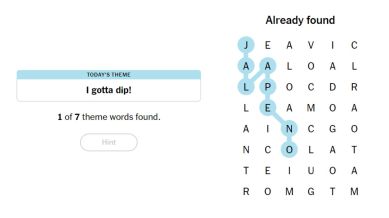How do you play Strands, NYT’s new word game?
Strands is the latest addition to The New York Times’ growing empire of puzzle games. We explain how to play.

Scrabble-meets-wordsearch is how one could describe ‘Strands’, a new puzzle launched by The New York Times this Monday. Edited by Tracy Bennett—who also curates Wordle—the game is currently in beta testing. If you like crosswords, finding patterns or just sleuthing around detective-style, this thoughtful title is worth a try.
How to play Strands
The game begins with a 6×8 jumbled grid of letters. This grid has a hidden theme. Your task is to find all the words related to this theme. Once you do, the remaining letters on the grid will spell out a ‘spangram’ revealing the theme.
The more related words you uncover, the easier it gets to guess the overall theme. If you’re good at trivia, you could potentially guess the spangram before finding all its related words. On the side, a phrase hinting at ‘Today’s Theme’ steers players in the right direction.
To make words, players can tap letters in the order they want them joined. Double tap on the last letter, and the word gets submitted. If you can’t find the themed words, Strands also lets you make random English words on the grid. Make a certain number of these, and you can trade them for a hint.
The hint appears as circled letters, showing players what can be connected to form a themed word. Players should use these hints as practice, until they can eventually predict how the game’s setter thinks in terms of designing the spangram and its related words.
Why is the overall theme called a ‘spangram’? Because it will always span the entire grid, touching two opposing ends, while pushing you to find the right anagrams using the available letters. Anagrams are a form of wordplay where you make words by rearranging any set of letters.
On Strands, all the themed anagrams you find get highlighted in blue. The final spangram appears in yellow. The game is similar to Connections, another NYT puzzle where you find hidden links that tie together a seemingly ‘meaningless’ grid.
[SPOILERS] Solving Strands using today’s puzzle as an example
On the Strands grid for March 6, the spangram you’re looking for is GUACAMOLE. But you wouldn’t know this. So you start looking for random words on the grid. As you explore, words like TOMATO, LIME and JALAPENO pop up. This would hint at a culinary connection. The ‘Today’s Theme’ box on the side says ‘Let’s take a dip!’. This suggestion, combined with what you’ve found so far, would confirm that you need to think about food (and not, say, swimming).
What kind of dips use these ingredients? SALSA is an obvious choice, but there is no S on the grid. So you must look for more ‘ingredients’ to find the true spangram. You chance upon AVOCADO, and voila, the pieces fall into place. Guacamole is an avocado-based dip, and it is unlikely the game’s setter would have chosen anything else that is too obscure (and thus, unguessable) to be the answer. This kind of reverse-engineered thinking is handy for solving a wide array of puzzles.
Ever since Wordle, there has been a Renaissance of sorts in the world of puzzle and word games. Apart from having fun, many claim that these games serve as effective ‘brain training’ activities. But can puzzles actually make you smarter? Or have people confused causation with correlation? We explore this topic here.